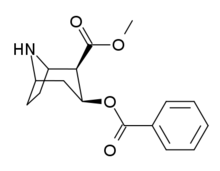Norcocaine
 | |
| Clinical data | |
|---|---|
| ATC code |
|
| Legal status | |
| Legal status |
|
| Identifiers | |
| |
JSmol) | |
| |
| |
| (verify) | |
Norcocaine is a minor metabolite of cocaine. It is the only confirmed pharmacologically active metabolite of cocaine,[1] although salicylmethylecgonine is also speculated to be an active metabolite. The local anesthetic potential of norcocaine has been shown to be higher than that of cocaine,[2][3] however cocaine continues to be more widely used. Norcocaine used for research purposes is typically synthesized from cocaine. Several methods for the synthesis have been described.[4][5]
Legal status
The legal status of norcocaine is somewhat ambiguous. The US DEA does not list norcocaine as a controlled substance.[6] However, some suppliers of norcocaine, like Sigma-Aldrich, consider the drug to be a Schedule II drug (same as cocaine) for the purpose of their own sales.[7][8]
Toxicity
The LD50 of norcocaine has been studied in mice. When administered by the intraperitoneal route, the LD50 in mice was 40 mg/kg.[9]
Controversy
Some researchers have suggested that hair drug testing for cocaine use should include testing for metabolites like norcocaine.[10] The basis for this suggestion is the potential for external contamination of hair during testing. There is considerable debate about whether current means of washing hair samples are sufficient for removing external contamination. Some researchers state the methods are sufficient,[11][12] while others state, the residual contamination may result in a false positive test.[10][13][14][15] Metabolites of cocaine, like norcocaine, in addition to cocaine, should be present in samples from drug users. Authors have stated that the metabolites should be present in any samples declared positive.[10] Issues arise because the metabolites are present in only low concentrations. If the metabolites are present, it is possible for them to be from other contamination.[16]
References
- ^ "Virtual Mass Spectrometry Laboratory: Cocaine in Hair". Archived from the original on 2007-09-01. Retrieved 2008-01-14.
- S2CID 10708670.
- S2CID 32483810.
- .
- PMID 102759.
- ^ "Controlled Substances" (PDF). dea.gov. United States Drug Enforcement Administration, United States Department of Justice. 9 September 2014. Archived from the original (PDF) on 17 April 2016. Retrieved 8 December 2014.
- ^ B.S, Amanda Stevens (2022-06-05). "Symptoms & Risks Of Cocaine Use & Abuse". Retrieved 2023-04-15.
- ^ "Norcocaine". sigmaaldrich.com. Sigma-Aldrich Co. LLC. Retrieved 8 December 2014.
- PMID 6927046.
- ^ PMID 1960975.
- S2CID 39938511.
- ^ Baumgartner WA, Hill VA (1992). "Hair analysis for drugs of abuse: Decontamination issues". Recent Developments in Therapeutic Drug Monitoring and Clinical Toxicology.
- ^ Henderson GL, Harkey MR, Jones RT, Zhou C (23 September 1991). "Effect of External Contamination on the Analysis of Hair for Cocaine". Paper Presented at the Joint Meeting of Forensic Toxicologists and the Canadian Society of Forensic Scientists, Montreal, Quebec, Canada.
- PMID 8309210.
- PMID 8138216.
- PMID 1293409.
